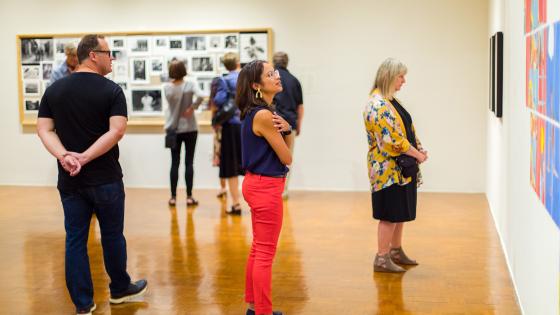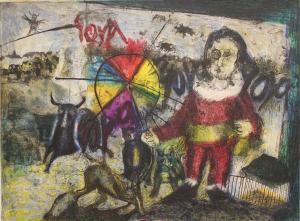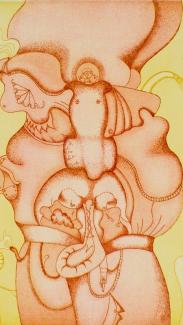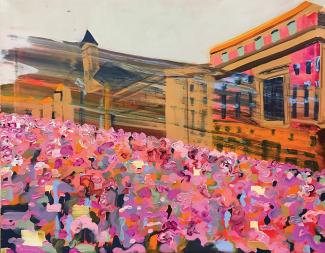Archive of past exhibitions presented chronologically below.

Past Exhibitions
2024
- Disguise the Limit: John Yau's Collaborations
- Jan 9 - June 1, 2024
- Walid Raad: Sweet Talk: Commissions (Beirut)
- Jan 9 - June 1, 2024
- Susan Silas: natural histories
- Aug 1, 2023 - Jan 20, 2024
- Barbara Rossi: Bodily Forms
- Aug 1, 2023 - Jan 20, 2024
- Edward Fisk: Legacies
- Aug 1, 2023 - Jan 20, 2024
2023
- Marlene McCarty: Thicker than Water
- Aug 23, 2022 - Jan 14, 2023
- RAUSCHENBERG: A Gift in Your Pocket from the Collections of Friends in Honor of Bradley Jeffries
- Aug 23, 2022 - Jan 7, 2023
- Louis Zoellar Bickett: Wrapped and Waxed
- Aug 23, 2022 - Jan 14, 2023
- Site of a Dangerous Leap
- Jan 10 - May 27, 2023
- Ralph Eugene Meatyard: Georgetown Street
- Feb 7 - July 8, 2023
- Among Women
- Feb 7 - July 8, 2023
2022
- Sally Davies: New Yorkers
- Oct 12, 2021 to Mar 19, 2022
- After
- Oct 12, 2021 to Mar 19, 2022
- Spaces - Bodies - Objects
- Oct 12, 2021 - Mar 19, 2022
- Bookworks II
- Oct 12, 2021 - Mar 19, 2022
- Mortal Coil: James "Son Ford: Thomas & David Farris
- July 5 - Nov 22, 2022
- The Life and Death of Charles Williams
- July 5 - Nov 22, 2022
- Francisco de Goya: Los Disparates
- Apr 12 - July 30, 2022
- Guy Mendes: Cohorts
- Apr 12 - July 30, 2022
- Todd Hido: The Poetry of Darkness
- Jan 18 - June 4, 2022
- Brilliant Illusions: Crafted Forms by Li Hongwei
- Jan 18 - June 4, 2022
2021
- The Exquisite Landscape
- Apr 20 - Sept 18, 2021
- Treasures from the Ancient Middle East
- Apr 20 - Sept 18, 2021
- Bookworks
- Apr 6 - Sept 18, 2021
- Intersections: Gifts from Henry V. Heuser, Jr.
- Apr 6 - Sept 18, 2021
- Hermann Kätelhön: Das Werk Arbeit
- Apr 6 - Sept 18, 2021
- Sew What: Jessie Dunahoo, Elana Herzog, Ben Venom
- Mar 16 - July 10, 2021
- Come Together: Assemblage and Collage from the Collection
- Mar 16 - July 10, 2021
2020
- Celebration of Donors: Richard B. Freeman and the Patrons of Graphics
- Nov 10, 2020 to Apr 3, 2021
- Face Off: Patrick Smith with Victor Hammer
- Nov 10, 2020 to Apr 3, 2021
- Larry Rivers: Boston Massacre
- Nov 10, 2020 to Apr 3, 2021
- Paul Sawyier: Kentucky Watercolors
- Oct 27, 2020 to Mar 20, 2021
- How 'Bout Them Cats
- Oct 27, 2020 to Mar 20, 2021
- Jeanne Silverthorne: More Flesh and Bone
- Oct 6, 2020 to Feb 13, 2021
- Erika Larsen: Ritual for a Changing Planet
- Jan 25, 2020 to Oct 10, 2020
- Robert C. May: The Photographer
- Jan 25, 2020 to Oct 24, 2020
- A Celebration of Donors
- Jan 25, 2020 to Oct 24, 2020
- Susan King: Redressing the Sixties
- Jan 25, 2020 to Sep 12, 2020
- Body Language: Hunter Stamps and Mike Goodlett
- Jan 25, 2020 to Sep 12, 2020
- The Sketch: Willard Leroy Metcalf and Thomas Satterwhite Noble
- Jan 25, 2020 to Mar 20, 2021
- Cabinet of Wonder - Online
- May 15, 2020 to Nov 1, 2020
- This is America*
- Oct 6, 2020 to Feb 13, 2021
2019
- Michael Flomen: Recent Work
- Jan 26, 2019 to May 5, 2019
- TLC: Conservation and the Collection
- Jan 26, 2019 to Aug 4, 2019
- CoBrA: Hope After Destruction
- Jan 26, 2019 to Jun 30, 2019
- Stephanie Syjuco: Recent Work
- Jan 26, 2019 to Aug 5, 2019
- Pushing the Envelope: Mail Art from the Archives of American Art
- Feb 16, 2019 to May 5, 2019
- Off the Menu: Looking at Food
- Jun 1, 2019 to Aug 11, 2019
- Ralph Steadman: A Retrospective
- Feb 16, 2019 to May 5, 2019
- Illumination
- Jun 1, 2019 to Dec 8, 2019
- The Good Earth
- Jun 1, 2019 to Feb 9, 2020
- Mistaken Identity
- Jun 1, 2019 to Dec 8, 2019
- TLC, Part II: Conservation and the Collection
- Aug 17, 2019 to Feb 17, 2020
- Encounters
- Jul 13, 2019 to Dec 8, 2019
- Laura Letinsky: Recent Works
- Sep 14, 2019 to Dec 8, 2019
- Bethany Collins: Benediction
- Sep 14, 2019 to Dec 8, 2019
- Interwoven: Joan Snyder, Judy Ledgerwood, Crystal Gregory
- Sep 14, 2019 to Dec 8, 2019
2018
- Water Ways
- Jan 13, 2018 to Jul 22, 2018
- Looking at Men
- Jan 13, 2018 to Apr 8, 2018
- Edward Melcarth: Points of View
- Jan 13, 2018 to Apr 8, 2018
- R.C. May Photography Lecture Series: Dan Estabrook
- Jan 13, 2018 to Apr 1, 2018
- American Impressions
- Feb 24, 2018 to Jul 22, 2018
- In the Abstract, Part II
- Feb 24, 2018 to Jul 22, 2018
- On Sitting
- May 4, 2018 to Jul 22, 2018
- Up in Arms
- Apr 13, 2018 to Jul 22, 2018
- Reuben Kadish: Witness
- May 11, 2018 to Jul 29, 2018
- Frankensteinian
- May 11, 2018 to Jul 29, 2018
- Alix Pearlstein: Grass
- Sep 8, 2018 to Dec 9, 2018
- Ralph Eugene Meatyard: Stages for Being
- Sep 8, 2018 to Dec 9, 2018
- Downstage from Meatyard
- Sep 8, 2018 to Dec 9, 2018
2017
- The Gaines Challenge Fund
- Jan 18 - May 20, 2017
- Cityscapes
- Jan 18 - May 20, 2017
- Andrea Modica: Best Friends
- Jan 18 - May 20, 2017
- Embodied
- Jan 18 - May 20, 2017
- Still Lifes
- Jan 18 - May 20, 2017
- Mike McKay: Singularities
- Jan 28 - Apr 23, 2017
- Face Value: Photographs by Doris Ulmann & Andy Warhol
- Jan 28 - Apr 23, 2017
- Frank Doring: I Would Redesign That Udder
- May 20 - Aug 20, 2017
- Thomas Nozkowski: Touchstones
- May 20 - Aug 20, 2017
- R.C. May Photography Lecture Series: Teju Cole
- Oct 7 - Dec 15, 2017
- R.C. May Photography Lecture Series: Lori Nix
- Oct 7 - Dec 15, 2017
- Alison Saar: Breach
- Sep 9 - Dec 3, 2017
- Modern Women
- Dec 2, 2017 - Apr 8, 2018
- Hugh Evans: Recent Gifts
- Dec 2, 2017 - Apr 1, 2018
2016
- Bill Adams: Blue Madness
- Jan 23 - Apr 3, 2016
- Open House: Selections from the Sue and John Wieland Collection
- Jan 23 - Apr 3, 2016
- Natalie Frank: The Brothers Grimm
- May 6 - Jul 31, 2016
- Lawrence Tarpey: Figures & Ground
- May 6 - Jul 31, 2016
- Paul Shambroom: Lost
- Mar 4 - May 22, 2016
- One + One
- Feb 12 - May 22, 2016
- Ralph Eugene Meatyard & Duane Michals: Camera Drama
- May 6 - Jul 31, 2016
- James Baker Hall: The Poet's Eye
- Jul 30 - Nov 27, 2016
- POTUS
- Jul 30 - Nov 27, 2016
- Louis Zoellar Bickett: Saving Myself
- Aug 27 - Nov 27, 2016
- Donald Lipski: Pieces of String Too Short to Save
- Jul 30 - Nov 27, 2016
- Mira Schor: Time & Flesh
- Jul 30 - Nov 27, 2016
2015
- Edward Troye: Theme and Variation
- Jan 24 - Apr 12, 2015
- Same Difference: Michelle Grabner, Simone Leigh, Russell Maltz
- Jan 24 - Apr 12, 2015
- Lexington Tattoo Project
- Jan 24 - Apr 12, 2015
- Tanya Habjouqa: Recent Photographs
- Jan 24 - Apr 12, 2015
- "(In the) Paint" with Craig Drennen
- Feb 11 - Feb 13, 2015
- Vivian Maier: On the Street
- May 9 - Jul 26, 2015
- Other Streets: Photographs from the Collection
- May 9 - Jul 26, 2015
- Chester Cornett: Beyond the Narrow Sky
- May 9 - Jul 26, 2015
- Wayne Koestenbaum: Unfamiliar Grammar, Paintings from 2010-2015
- Sep 12 - Dec 20, 2015
- Robert C. May Photography Endowment Lecture Series: Nina Katchadourian
- Sep 12 - Dec 20, 2015
- Bottoms Up: A Sculpture Survey
- Sep 12 - Dec 20, 2015
- Sculptors on Paper
- Sep 12 - Dec 20, 2015
2014
- Wide Angle: American Photographs
- Jan 26 - Apr 27, 2014
- Robert C. May Photography Series: Catherine Opie
- Feb 7 - Mar 9, 2014
- Robert C. May Photography Endowment Lecture Series: Eugene Richards
- Mar 14 - May 18, 2014
- Landscape/Mindscape: Selections from the Wells Fargo Collection
- May 18 - Aug 17, 2014
- Take My Word For It
- Sep 6 - Dec 23, 2014
- Prints for the People: Student Research on the WPA Collection
- Mar 23 - Jul 27, 2014
- Laurel Nakadate: Strangers and Relations
- Sep 6 - Dec 23, 2014
- Kurt Vonnegut: Madmen and Moonbeams
- Sep 6 - Dec 23, 2014
2013
- Innovators and Legends: Generations in Textiles and Fibers
- Oct 13 - Dec 23, 2013
- Robert C. May Photography Endowment Lecture Series: Penelope Umbrico
- Oct 18 - Nov 10, 2013
- Robert C. May Endowment Photography Series: Carl Corey
- Nov 15, 2013 - Feb 2, 2014
- What Dreams May Come: Works on Paper from the Permanent Collection
- Dec 20, 2013 - Jul 27, 2014
Works from Our Exhibition Archives
Click on each image for details.





